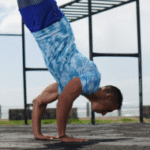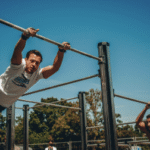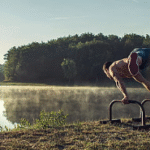Can You Achieve Elite Calisthenics Skills Without Private Coaching? A Detailed Guide
In the world of calisthenics, the pursuit of elite skills—the freestanding handstand push-up, the flawless muscle-up, the gravity-defying planche—is the ultimate goal for many dedicated athletes. In a city like Houston, with its vibrant fitness community and numerous parks perfect for training, the resources to learn seem endless. This raises a critical question: with so much information available online, can you truly achieve these high-level skills without the personalized guidance of a one-on-one coach?
The short answer is yes, it is possible. The internet is filled with stories of incredible self-taught athletes who have achieved mastery. However, the long answer is far more complex: the path of the self-taught athlete is significantly harder, slower, and carries a much higher risk of injury and frustrating plateaus. This guide will provide a detailed, realistic comparison.
The Allure of the Self-Taught Path: Why People Choose It
It’s easy to see why so many attempt to learn on their own.
Abundance of Information: There are countless high-quality tutorials on YouTube, Reddit (like the r/bodyweightfitness community), and dedicated online programs from world-class athletes.
Cost-Effectiveness: Private coaching is a significant financial investment. Learning for free or for the low cost of an online program is highly appealing.
Flexibility: You can train whenever and wherever you want, without being tied to a coach’s schedule.
The Major Hurdles: Why the Self-Taught Path Often Fails
While possible, the solo journey is fraught with challenges that a coach is specifically trained to solve. These are the four great roadblocks you will face.
- The Unseen Form Flaw (The Biggest Danger)
This is, without a doubt, the most significant risk. You cannot see your own mistakes.
The Problem: You might feel like your back is straight in a handstand, but in reality, you have a significant arch (a “banana back”). You might feel like you’re pulling evenly in a muscle-up, but one arm is coming over before the other (a “chicken wing”). These are subtle errors that are almost impossible to self-diagnose.
The Consequence: Practicing with flawed form for months ingrains bad neuromuscular patterns that are incredibly difficult to unlearn. More importantly, it places enormous stress on your joints (shoulders, elbows, wrists), making injury not a matter of if, but when.
- The Labyrinth of Programming
Getting stronger isn’t just about “trying hard.” It’s a science.
The Problem: A self-taught athlete often falls into the trap of doing random workouts or only practicing the skills they enjoy. They may not understand the principles of progressive overload, periodization, or the importance of accessory work to strengthen weak links.
The Consequence: You hit a plateau. Your progress stalls because you’re not providing your body with the right kind of stimulus at the right time. You might have the raw strength for a front lever, but you’ve neglected the specific scapular depression strength needed to hold it.
- The Inevitable Plateau
Every athlete hits plateaus. A coach sees a plateau as a data point; a self-taught athlete often sees it as a failure.
The Problem: You’ve been stuck on the tuck planche for six months and can’t progress. Frustration sets in, and motivation plummets.
The Consequence: Without an external, experienced perspective to diagnose the problem (e.g., “Your issue isn’t shoulder strength, it’s your core’s ability to maintain posterior pelvic tilt”), you’re likely to either quit or try to “force” the next progression, leading to injury.
- The Lack of an Objective Eye
A coach provides unbiased feedback.
The Problem: You are emotionally invested in your progress. It’s easy to convince yourself you’re ready for the next step when you’re not.
The Consequence: This leads to “ego lifting” in a bodyweight context—attempting skills your connective tissues are not prepared for, which is a fast track to tendonitis or more severe injuries.
The Blueprint for a Successful Self-Taught Journey
If you are committed to the self-taught path, you must approach it not just as an athlete, but as a student and a scientist.
Become an Obsessive Student: Don’t just watch tutorials; study them. Learn the basic anatomy and biomechanics behind the movements. Understand why a protracted scapula is essential for the planche.
Your Smartphone is Your Coach: This is your most crucial tool. Record every single attempt of a skill from multiple angles (especially the side). Watch it back immediately and compare it frame-by-frame to a video of an expert with perfect form. Be brutally honest with your self-assessment.
Follow a Structured, Reputable Program: Do not do random workouts. Choose a well-regarded online program and follow it to the letter for at least 3-6 months. Consistency with a good plan is better than inconsistency with a “perfect” one.
Prioritize “Prehab” and Mobility: Dedicate a significant portion of your training to pre-habilitation exercises for your wrists, elbows, and shoulders. This includes wrist push-ups, German hangs, face pulls, and scapular drills. This is your injury insurance.
Engage with the Community: Post form-check videos on communities like r/bodyweightfitness. While not the same as a coach, getting feedback from experienced peers can be incredibly valuable.
The Hybrid Model: The Smartest Path for Most
For many athletes in Houston, the most effective solution is a hybrid approach that combines the best of both worlds.
The Strategy: Invest in a small package of 5-10 private sessions with a qualified calisthenics coach.
The Goal of These Sessions:
Get a professional, in-person assessment of your strengths, weaknesses, and mobility limitations.
Learn the correct form for the foundational exercises and the key cues for your specific body.
Receive a personalized program that you can then follow on your own.
The Follow-Up: Schedule a single check-in session every 1-2 months to have your coach review your progress, correct any new form errors, and adjust your program.
This approach gives you the expert foundation and safety net of a coach while allowing you the flexibility and affordability of training on your own.
Conclusion:
Yes, you can achieve elite calisthenics skills without a full-time private coach. However, the path is treacherous and requires an extraordinary level of discipline, self-awareness, and dedication to studying the craft. For most people, the investment in at least a few private sessions is the single most effective way to accelerate progress, ensure safety, and build a solid foundation for a long and successful calisthenics journey. It transforms your training from a process of guesswork into a clear and intelligent plan.

Can You Achieve Elite Calisthenics Skills Without Private Coaching? A Detailed Guide
Route
Calisthenics Gym Houston Functional Bodyweight Training
Secondary phone: (346) 483-3195
Email: info@calisthenicsclubhouston.com
URL: https://calisthenicsclubhouston.com/
Monday 6:00 AM - 7:00 PM Tuesday 6:00 AM - 7:00 PM Wednesday 6:00 AM - 7:00 PM Thursday 6:00 AM - 7:00 PM Friday 12:00 PM - 6:30 PM Saturday 9:45 AM - 12:00 PM Sunday 3:00 PM - 5:00 PM





